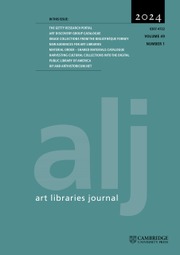This issue of Art Libraries Journal includes articles with disparate subjects, though underlying themes weave the projects and endeavours together – all of the writers seek to help users more easily find information and to make their collections more accessible to diverse populations of users. Stefanie Hilles guides us through academia’s ever-increasing use of AI image generators – and in particular how librarians can effectively help students navigate the murky waters of critically engaging with AI image generators. Pam Young illuminates two projects at the Victoria and Albert Museum that use machine learning tools to analyse and flag potentially problematic terminology and to enhance access to stored collections by generating fragility ratings based on collections data. Jackie Shieh explains in detail the Smithsonian’s use of the BIBFRAME ontology with a linked open data framework to more effectively reveal hidden collections to broader audiences. Tatiana Walther, Birte Rubach, Georgy Litvinov, and Christian Hauschke write about the GESAH Graphic Arts Ontology, a project that introduces a new way to describe works on paper (the art and its digital representation) that is tailored to experts in graphic arts with the goal of increased discovery of the described resources. Olivera D. Nastić shines a light on the use of social media in the art libraries of Hungary, Serbia, Bulgaria, Croatia and Slovenia and illuminates the growing use of social media platforms by museum professionals. Lori Salmon and Annalise Welte present a way forward for libraries to implement collection development policies that prioritize materials by underrepresented groups. They hold a microscope to collection development at the NYU Libraries’ Institute of Fine Arts Library focusing on the African American and Black Diaspora, Asian, and Latin American & Caribbean art collections. James Blake looks closely at problematic aspects of Sotheby’s Institute of Art’s in-house book classification scheme – the use of the terms: the Dutch Golden Age, MENA/SWANA, and the Global South/Global North, as a microcosm of the ongoing task of making library collections and services more unbiased. Finally, last but certainly not least, Suzanna Hall looks closely at how the International Library of Fashion Research, in Oslo, Norway, has incorporated fashion ephemera (lookbooks, invitations, show notes and other fashion show ephemera meant to be discarded after use) as key elements in fashion research.
No CrossRef data available.


